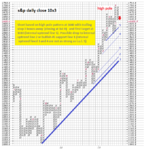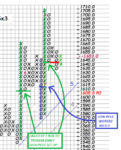quite often ...there is no real need for a p/f chart
this is a line dot chart
the dots are the close
in this chart it is 5 min gld
the same as p/f chart that plots the close
trend today shows up nicely
Hi Dentist007.
I've tried different kinds of price analysis in order to make profit, but haven't managed to find one that would bring consistent profitability. That's the main reason behind my decision to try point and figure. It's an old way (more than 120 years?) and traders still use it – so it should be all right?
Anyway I was surprised when you posted non p&f chart. Is it because you find it difficult to maintain profitability with using only p&f charts?
I hope you don't mind the question – it's only me trying to see if it's worth getting involved in it (if it can help with consistent profit making, or is it just another time wasting way good for analysts/software providers and book writers only)





